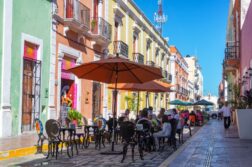Suzanne Rowan Kelleher Senior Contributor Travel
“This is the last time I’ll be flying for a very long time,” Dr. Ethan Weiss tweeted yesterday from a crowded United Airlines flight from Newark to San Francisco. “People on this plane are scared/shocked.”
Dr. Weiss, an associate professor at the University of California San Francisco’s Cardiovascular Research Institute, had just spent two weeks volunteering at New York-Presbyterian Hospital during the COVID-19 crisis. “I am with a group of 25 nurses and doctors who have been working in NYC hospitals for the past 2-4 weeks. We are coming home,” he tweeted. (If you’re interested in learning what Weiss’s experience was like, his journal entries are in his Twitter feed. Here’s Day One.)
Since early April, United Airlines has been providing free round-trip flights to New York City for medical volunteers who wanted to help fight against the COVID-19 crisis.
Yesterday, Weiss tweeted a selfie that shows his jam-packed plane, with every seat on the 737 aircraft filled.
The number of passengers caught Weiss a bit off-guard, since his flight to New York two weeks ago was only about a third full. “I’ve heard from a lot of people who have been doing these medical trips that the number of passengers on the plane has been increasing pretty steadily over the past month,” he says. “My colleagues who came out a month ago said their flights were completely empty.”
On April 22, United announced with great fanfare that it would begin blocking middle seats in all aircraft cabins in an effort to promote social distancing during the COVID-19 pandemic. The carrier has also said it would also use back-to-front boarding to give passengers more space as they walk onto a plane, and process all seating upgrades at the airport to better control crowding. According to United, these new procedures would remain in effect through May 31.
The COVID-19 page on United’s website offers more watered-down language. “Though we cannot guarantee that all customers will be seated next to an unoccupied seat, based on historically low travel demand and the implementation of our various social distancing measures, that is the likely outcome,” reads the section on social distancing. It also notes that the airline will limit seat selections “where available.”
“I guess a lot has changed in 10 days,” tweeted Dr. Weiss, along with a screenshot of an April 30 email sent from United Airlines entitled “A note from our Chief Customer Officer.” The email runs through all the steps United was taking to make passengers safe during the coronavirus pandemic. “We’re automatically blocking middle seats to give you enough space on board,” said the email.
Still, Weiss had his PPE. “I was prepared, and I was treating flying like I was walking into an ICU filled with COVID patients,” he says. “But a lot of other passengers were confused and scared and didn’t really understand what was going on.”
Weiss faults United for a major communication fail that gave an expectation of more space between passengers. “Most of what happened yesterday was a reaction to the fact that they [United] had been telling everyone that the middle seat was blocked,” he says.
During boarding, some passengers began to argue with those assigned to the middle seat. “These poor people who had tickets to sit in the middle seat didn’t want to be there anyway, and they were getting yelled at by people who were sitting on the aisle or at the window,” says Weiss.
“I think United got lucky that this particular group of people did not go apeshit,” he says. “I thought that when people on that plane started figuring out what was going on — that they were there with 25 medical personnel who had just spent the last two to four weeks in an ICU — that some of them would have gone crazy. It was surprising to me that it didn’t get more unruly, but I guess everyone just wanted to get where they wanted to get.”
Many major airlines claim to be taking steps to ensure social distancing, whether by blocking middle seats or capping the number of seats sold per flight.
But the reality is that air travel in the United States is down more than 90 percent due to the coronavirus pandemic, and airlines have chopped routes and canceled thousands of flights. The result is fewer planes in the air, at the same time there has been an uptick in travelers passing through TSA checkpoints in recent weeks. That combination means that many flights are full.
“You can’t tell people that it’s going to be a half-empty flight with empty middle seats and then have people show up and not have it that way,” says Weiss. “The problem with what happened yesterday, is I think there was such a disconnect between people’s expectations and the reality.”
Weiss understands why Americans are reluctant to fly in today’s environment, and says he would not fly for a leisure trip. “I think people are smart,” says Weiss. “Why would you choose to be crammed into a tube with other people? It is counter to everything we’ve been told for the past two months.”
As he was signing out of his last shift at the hospital on Friday night, Weiss says he told a group of physicians that he was actually more nervous about getting on an airplane than walking into a COVID ICU.
“I don’t see a time in the near future or middle future when that would change,” he says. “I wouldn’t get on another airplane for a very long time, unless I absolutely had to.”




